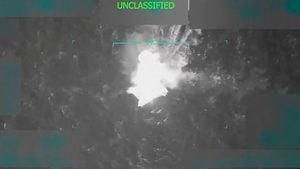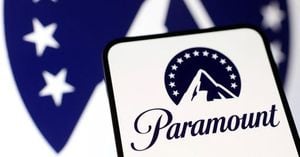On January 28, 2025, Boom Supersonic's XB-1 jet made waves—literally—by breaking the sound barrier during its historic test flight over the Mojave Desert, setting the stage for a potential revival of supersonic passenger travel. This successful flight marks the first time since the 2003 retirement of the famous Concorde jet, which catered to travelers seeking quick transatlantic flights, and signifies the beginning of what Boom Supersonic calls a new era of aviation.
The flight, which took place at the Mojave Air and Space Port, reached speeds of Mach 1.122 (approximately 1,207 km/h) at an altitude of 35,290 feet (10,750 meters). Company CEO Blake Scholl expressed pride over this achievement, emphasizing its significance not only for Boom Supersonic but for the entire civil aviation sector. "A small band of talented and dedicated engineers has accomplished what previously took governments and billions of dollars," Scholl stated following the flight.
The XB-1, affectionately dubbed the "Baby Boom," is positioned as the precursor to Boom's larger commercial airliner, Overture, which is intended to carry between 64 and 80 passengers at speeds of Mach 1.7 (about 1,304 mph). The company claims Overture could reduce the typical travel time between New York and London to just 3.5 hours—enough time for a leisurely watch of Gone with the Wind, providing all goes smoothly.
History was made at the same location where Chuck Yeager first broke the sound barrier back in 1947. Yeager's spirit lingered over the test as spectators watched the XB-1 soar, making it the first independently funded U.S. jet to reach supersonic speeds. With this remarkable feat, Boom aims to revolutionize air travel, which had stagnated since the Concorde's untimely end.
The Concorde, which flew its last flight over two decades ago, ceased operations amid high operating costs, noise complaints, and tragic accidents. Notably, on July 25, 2000, one crashed shortly after takeoff, leading to public scrutiny and eventual grounding of the fleet. Facing the same challenges, Boom Supersonic is striving to revitalize the dream of swift air travel, tackling issues like noise pollution head-on. The company has developed special turbofan engines intended to comply with modern noise standards, thereby aiming to avoid the tumultuous sound issues associated with earlier supersonic aircraft.
Looking toward the future, Boom Supersonic has already begun constructing its manufacturing facility in Greensboro, North Carolina, which will be responsible for producing Overture. The company projects it will eventually be capable of delivering up to 66 aircraft per year. Scholl is enthusiastic about the venture, declaring, "The future of aviation is here and now," and advocating for affordable supersonic travel accessible to everyone.
Financially, Boom Supersonic is not without backing. The company has secured pre-orders from major airlines, including American Airlines and United Airlines, totaling 130 units. The projected ticket price for trips on Overture is around $5,000—a substantial reduction from the exorbitant costs previously associated with flying on the Concorde, which could reach $20,000 per ticket.
Though the XB-1 has completed this successful flight, the team at Boom is not resting on their laurels. Future test flights are on the agenda, as engineers work diligently to apply lessons learned from the XB-1 to develop the Overture. With competitors like Boeing and Lockheed Martin also itching to achieve breakthroughs with their own supersonic and hypersonic models, the race is on for Boom to not only develop but also bring their vision of supersonic travel to fruition.
The excitement surrounding this technological revival is palpable, inspiring hope among aviation enthusiasts and potential travelers alike. The ambition to fly at faster speeds can change the logistics of long-distance travel, ushering in unprecedented convenience and efficiency. Boom's successful test flight of the XB-1 could be just the beginning of the next chapter for supersonic air travel.
While all eyes are on Boom Supersonic, it remains to be seen how regulatory and operational challenges will be navigated. Will Overture be permitted to traverse the skies freely, or will this next generation of supersonic travel have to adhere to stringent rules similar to those faced by the Concorde? Only time will reveal how successful Boom Supersonic will be at carving its niche within the modern aviation industry. Yet, for now, the sound of progress rings clearer than ever as the XB-1 ushers us back to the skies.



